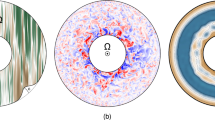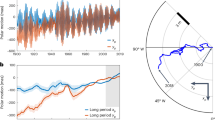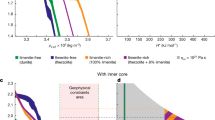Abstract
OSMASTON1 has pointed out that core convection might have important consequences with regard to the Earth's figure and continental drift, and that it is an extremely powerful cause of oblateness. He suggests that observations of J2 might indicate the amount of change in the magnetic field in the core and therefore the amount of core convection. He seems to be saying that the angular momentum of the Earth can be expressed as  where C and ω are the polar moment of inertia and angular velocity and 1, 2, 3 refer to the inner core, outer core and mantle respectively. The mantle and the crust are assumed to be rotating at the same speed; the transfer of angular momentum between solid and fluid parts of the Earth of this kind has also been suggested by Munk and MacDonald2.
where C and ω are the polar moment of inertia and angular velocity and 1, 2, 3 refer to the inner core, outer core and mantle respectively. The mantle and the crust are assumed to be rotating at the same speed; the transfer of angular momentum between solid and fluid parts of the Earth of this kind has also been suggested by Munk and MacDonald2.
This is a preview of subscription content, access via your institution
Access options
Subscribe to this journal
Receive 51 print issues and online access
$199.00 per year
only $3.90 per issue
Buy this article
- Purchase on SpringerLink
- Instant access to full article PDF
Prices may be subject to local taxes which are calculated during checkout
Similar content being viewed by others
References
Osmaston, M. F., Nature, 216, 1096 (1967).
Munk, W. H., and MacDonald, G. J. F., The Rotation of the Earth (Cambridge Univ. Press, 1960).
Little, W., Fowler, H. W., and Coulson, J., The Shorter Oxford Dictionary (revised and ed. by Onions, C. T.), (Clarendon Press, Oxford, 1959).
Kozai, Y., Proc. COSPAR-IAU-IUTAM Symp. (Paris, 1965).
Paddack, S. J., J. Geophys. Res., 72, 5760 (1967).
Author information
Authors and Affiliations
Rights and permissions
About this article
Cite this article
PADDACK, S. Comments on the Earth's Figure. Nature 224, 254–255 (1969). https://doi.org/10.1038/224254a0
Received:
Revised:
Issue date:
DOI: https://doi.org/10.1038/224254a0



